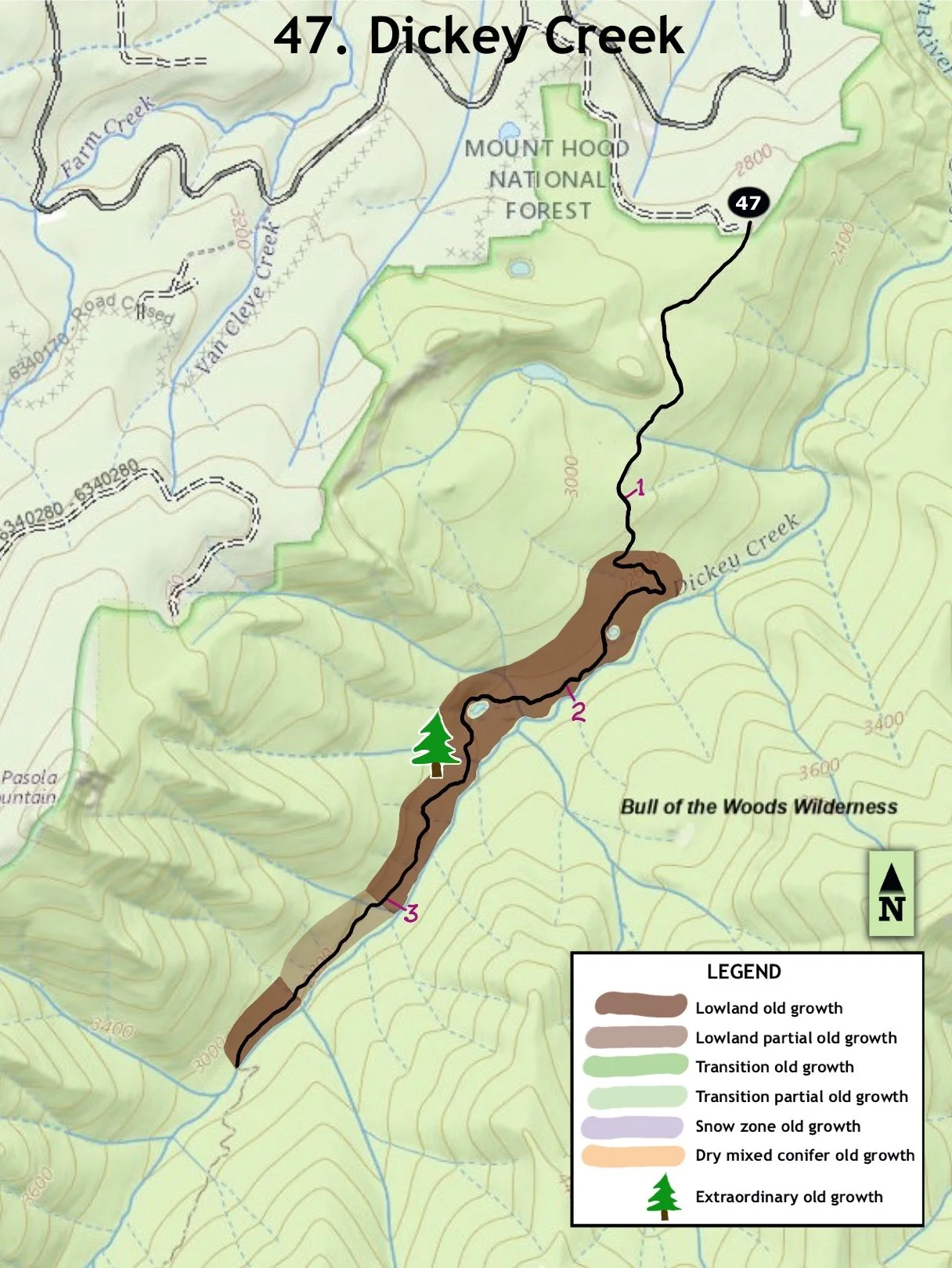
47. Dickey Creek
Summary
Length 3 ¾ miles one way
Difficulty Moderate, with occasional very steep pitches
Season Spring to autumn
Elevation range 2,480 – 2,950 feet
Human imprint Minimal (Bull of the Woods Wilderness)
Information Mount Hood National Forest (Clackamas River Ranger District)
Primary old growth features
Low elevation old growth, including an interesting expression on a deep-seated, slow-moving earthflow; unique grove of large red alder.
Description
The Dickey Creek Trail (553) accesses beautiful lowland old growth in a quiet, little-noticed nook of the Bull of the Woods Wilderness. The trail also traverses a large, deep-seated earthflow, which has strangely distorted the forest. Although the hike is of moderate length, the trail is seldom maintained and includes a few uneven and precipitous pitches over the earthflow.
The trail starts off on a decommissioned logging road, then descends fairly gently through an older plantation. The trail tread steepens abruptly a little over a mile from the trailhead as it enters sparse forest cover over the earthflow. Many standing trees are tipped in a variety of directions in response to this slow-motion phenomenon creating a funhouse version of a forest. Deep-seated earthflows typically move at nearly imperceptible rates, ranging from fractions of an inch to a few inches per year, enough to tilt trees but not topple them immediately. One large tree by the trail is actually pulling apart vertically as the earth does the splits. The jumbled and hummocky surface of the ground provides an additional indicator of earthflow activity, and causes the trail to follow an uneven course. Upon close inspection, some of the apparently dry stream drainages turn out to be tension cracks between portions of the ground moving at different rates.
The top of the earthflow can be seen from some distant locations as a rock scarp face along a geologic discontinuity between hard rock along the ridgeline and the landslide below. The scarp face lies to the northeast of Pasola Mountain and can easily be seen from Google Earth or other sources of aerial imagery. A look at a topographic map reveals that the landslide has gradually pushed Dickey Creek to the east, feeding the stream with sediment and trees as the toe of the slide erodes during high stream flows.
Old growth begins in earnest near the bottom of the landslide and continues for approximately two miles. Classic Douglas-fir 3-4 feet thick mingle with western hemlock and western redcedar in a relatively open upland forest. Most of the larger trees are approximately 300 years old, although sharp-eyed observers can spot a few older and larger veterans mixed in, especially after passing to the west of a small pond and dropping down to a riparian terrace. Individual trees also tend to be larger near streams and lower slopes where soils are deeper and well-watered.
Another interesting and unusual aspect of the hike are large red alders found along the stream margin and in a wet meadow just before the trail skirts a small pond. Red alder is a relatively short-lived deciduous species (usually dead by age 100) typically found near streams or wetlands. These attractive 2 to 3 feet thick specimens are near the upper limit of diameter growth for forest-grown alder in the Oregon Cascades.
The trail briefly climbs around a rock outcrop about 3 miles from the trailhead, and then drops down to a final patch of old growth before reaching a bridgeless crossing of Dickey Creek. The stream crossing marks an excellent break spot and a sensible turnaround point for most day hikers. For more adventurous hikers, the trail continues across the stream, turning steeply uphill through forest burned by the Bull Complex (2021) on a tack toward Big Slide Lake and multiple trail junctions on the distant ridgeline.
30 Years of Change
The forest and earthflow both appear broadly similar as 30 years ago. The access road is now blocked a half mile earlier adding a mile to the hike length, and the wilderness boundary has been expanded to the north, including portions of an old clearcut and former logging road.
How to get there
Turn right onto the Collowash Road (FR 63) from the Clackamas River Highway (FR 46) by the River Ford Campground approximately 29 miles southeast of Estacada. Turn right approximately 5.7 miles later onto FR 6340. Follow FR 6340 for 2.7 miles, then turn left onto FR 140. Park at the trailhead at the end of the road in approximately one mile.

Old Douglas-fir

Hemlock doing the splits

When the earth moves ... cracks result

A funhouse forest

Don't worry, it's moving in slow motion

An ancient one

Old red alder

Large red alder

Red alder with character

A streamside trio

Trailside pond and meadow

Douglas-fir snags
